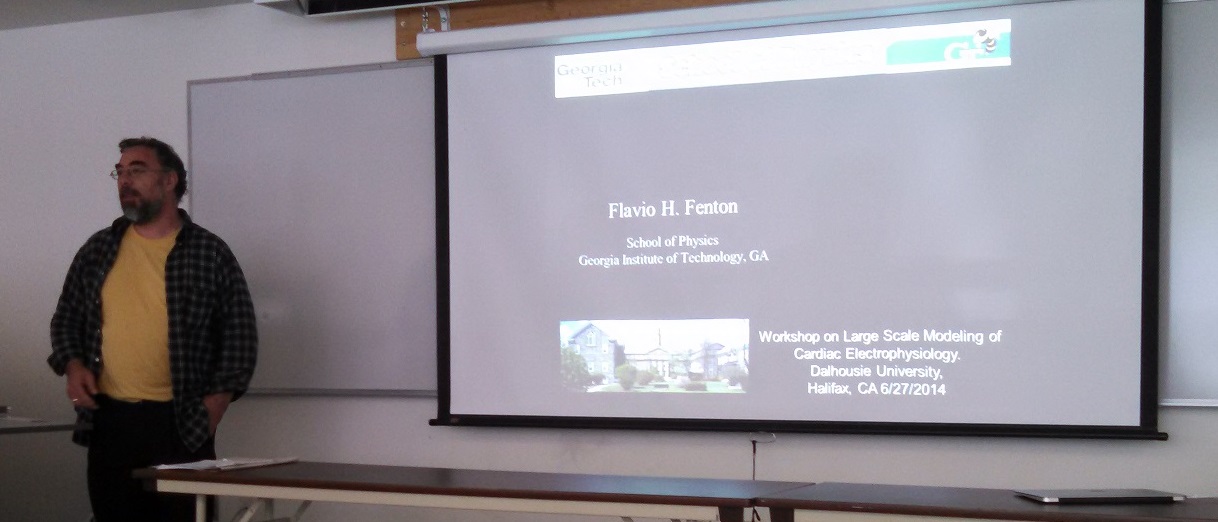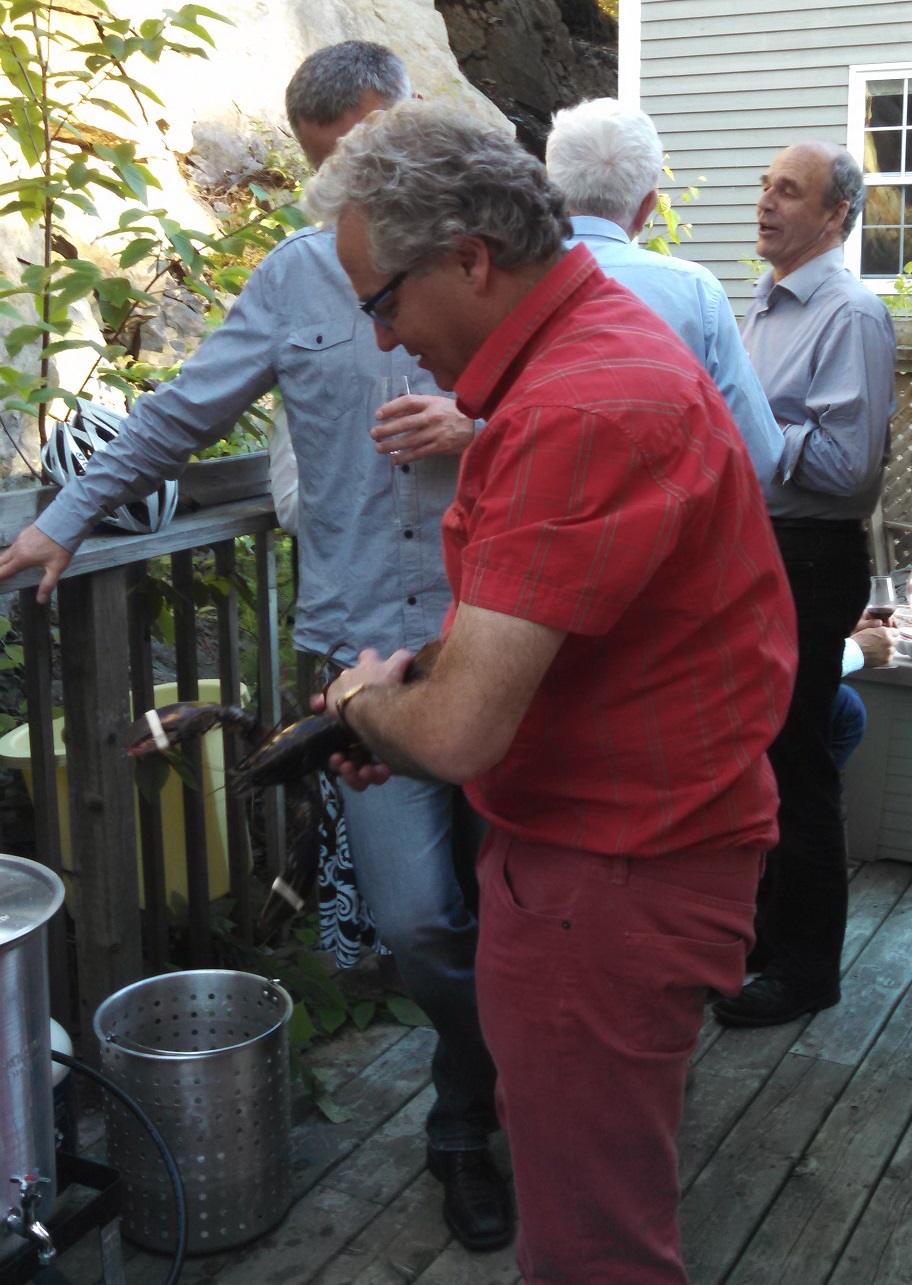The past, present, and future of modeling cardiac arrhythmias were discussed June 26-27, 2014, at the Winter’s Lecture Series Workshop on Large-scale Modeling in Cardiac Electrophysiology at Dalhousie University in Canada. The meeting consisted of nine formal presentations, plenty of discussion, and even a lobster dinner hosted by organizer L. Joshua Leon, Dean of the Faculty of Engineering at Dalhousie. Robert F. Gilmour, Jr., Vice President for Research and Graduate Studies at the University of Prince Edward Island, and Milan Horacek, Professor at Dalhousie, co-organized the event, and support was provided by the Winter’s Lecture Series. Speakers included Elizabeth Cherry (Rochester Institute of Technology, USA), Flavio Fenton (Georgia Institute of Technology, USA), Craig Henriquez (Duke University, USA), Robert MacLeod (University of Utah, USA), Gernot Plank (Technical University of Graz, Austria), Natalia Trayanova (Johns Hopkins University, USA), Edward Vigmond (University of Bordeaux, France), Alain Vinet (University of Montreal, Canada), and Patrick Wolf (Duke University, USA).
In discussing the past, a number of speakers traced the history of cardiac electrophysiology modeling from its inception with the introduction of the Noble model, a cardiac-specific variation of the Hodgkin-Huxley neural model, in 1962. Major advances occurred again in the mid-1980s, when second-generation models introduced differential equations for ion concentrations along with expressions for pump and exchanger transmembrane currents essential for maintaining ionic homeostasis in cardiac cells. More recent models have added additional levels of detail, such as species-specific current descriptions and Markov-type models of different ion channels. At the same time, structural representations of cardiac tissue have matured as well, from simple 1D idealized geometries to fully 3D realistic geometries often derived from imaging and incorporating representations of current passing through both intracellular and extracellular space.
Early work in the field of modeling cardiac electrophysiology was dominated by seeking answers to key questions. Such driving issues included the role of geometry and anisotropy arising from fiber orientation during electrical impulse propagation in the heart as well as the mechanisms underlying the initiation, maintenance, and termination of spiral and scroll waves characteristic of fibrillation—questions that modeling work helped to answer.

Flavio Fenton begins his presentation on important cardiac electrophysiology phenomena that at present cannot be reproduced by models.
At present, modeling efforts are often fairly sophisticated. Structural models can be derived from imaging studies, often with MRI for overall anatomy and diffusion-tensor MRI for determining local fiber orientation and anisotropic properties. On the electrophysiology side, it is becoming clear that complexity is needed in many whole-heart contexts. For example, the specialized conduction system of the heart, which ensures the proper activation sequence and timing of the ventricles to produce an effective cardiac contraction, traditionally has not been included in simulation studies of ventricles. However, recent work has shown that this network can affect the induction and evolution of arrhythmias and also can affect defibrillation efficacy.
Despite the complexity of current modeling efforts, some fundamental questions remain. For example, the nature of the experimental bifurcation to alternans, a period-2 oscillation in action potential duration at a fixed period, and other higher-order rhythms remains unclear; the standard period-doubling bifurcation often used shows an unrealistically large growth rate and magnitude for the difference in long and short action potentials, so that other types of bifurcations, such as a border-collision bifurcation involving an underlying nondifferentiability, may be necessary. In addition, differences in action potential shapes and durations can be observed over much shorter length scales in experiments than in simulations; the straightforward diffusive coupling of cells typically used in models likely is too strong. Furthermore, the experimentally-observed increase in baseline voltage during fibrillation also is not currently reproduced by models, and its mechanism remains unclear.
In terms of applications, translational work involving collaborations with clinicians is driving an increasing number of research efforts. Treatment for atrial fibrillation, a common arrhythmia that becomes increasingly prevalent with age, can be quite complicated, and modeling efforts are helping in several areas. One clinical technique involves using a catheter to map electrical activity on the interior surface of the heart and to deliver radiofrequency energy to specific sites to interrupt recirculating electrical waves. Modeling approaches are being used to help determine where to apply this energy most effectively. In addition, modeling increased fibrosis development, which contributes to and complicates atrial fibrillation, is serving as a basis for clinical measures that predict event-free outcomes.

With the workshop concluded, Josh Leon prepares the lobster dinner.
The future application of cardiac modeling, according to many speakers, lies in focusing on expanded clinical applications. This represents a shift from the past several decades, when understanding arrhythmia mechanisms was emphasized. Current translational efforts will need be scaled up to the point where they can affect widespread clinical practice and not simply a few physicians. Promising areas include ablation targets and heart failure treatment. Antiarrhythmic drug development also has the potential to benefit from modeling work; for example, many drugs developed to treat arrhythmias like atrial fibrillation have not been successful, and it may be possible for modeling to contribute to identifying better biophysical targets. Among basic-science areas where open questions are likely to remain a significant driver of research, interactions between the nervous system and the heart in normal and diseased conditions came to the forefront. Modeling the cardiac autonomic nervous system, which consists of roughly 14,000 neurons with little known about their connectivity, remains an important modeling problem.
Other important challenges include improved modeling and computational approaches. In modeling, despite the overall sophistication of models, an abundance of models with vastly different behavior and the lack of widely accepted standards raise concerns about the reliability of these models and may hinder broader adoption of and reliance upon them. At present, however, validation efforts are limited and are complicated by factors like limitations of experimental methods and biological variability within and between hearts. The same issues have hampered efforts to determine standard parameter values for models of both normal and diseased hearts as well as the sensitivities of these parameters. Whether sensible standards, including benchmarks and validation targets, can be developed and adopted for both cell electrophysiology models and cardiac structural models remains an important open question. A serious concern is that modelers may be becoming a dying breed, because of the steep learning curve involved, delayed productivity arising from the significant development time needed, and a limited number of individuals with the appropriate highly cross-disciplinary skills and expertise that are demanded.
On the computational side, speed remains a bottleneck for some applications, but implementing more efficient options like GPU-accelerated programming can be complicated and require substantial multi-disciplinary efforts. Several different simulator tools are in use at present, but, most likely, these will narrow down to a smaller number. Unlike neuroscience, it is not expected that the field will dominated by a single software tool; instead, several efforts are likely to remain in competition, which, it is hoped, will help to maintain high quality, especially in the absence of funding mechanisms to support such large-scale efforts (the funding climate in Europe may be favorable than that in North America to providing such support).
Overall, cardiac modeling has come a long way from the early days; along the way, it has helped to answer important questions about the nature of cardiac electrical wave propagation and arrhythmias, and it presently is beginning to impact clinical practice. A number of challenges remain and should keep the field vibrant for decades to come.
Elizabeth Cherry